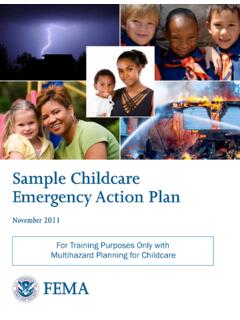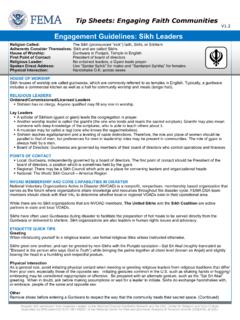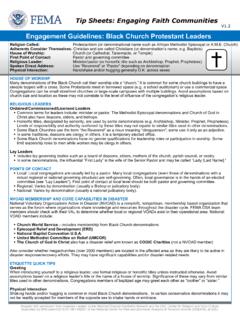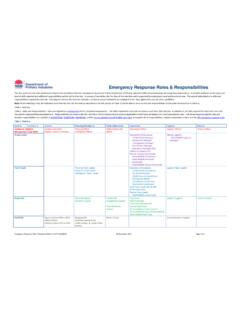Transcription of ICS for Public Works - FEMA
1 1 ICS for Public Works Why Is ICS Important for Public Works ? Before diving into why the Incident Command System (ICS) is important to Public Works , it is essential to understand the context through which ICS exists. ICS is a standardized management system, typically associated with on-scene emergency management operations, specifically designed to provide an integrated organizational structure that can manage the complexity and demands of single or multiple incidents. This includes taking into consideration potential jurisdictional boundaries, Public and private organizations, and many other factors including facilities, equipment, personnel, procedures, and communications operating within a common organizational structure, designed to aid in the management of resources during incidents. With over 40 years of usage, ICS is considered a best practice and is used worldwide.
2 It is the backbone of the National Incident Management System (NIMS). In California, ICS is an element of the State s Standard Emergency Management System (SEMS), which is a state law mandating that SEMS be used in response to incidents in the field. Public Works departments across the country serve their communities in a variety of ways. Depending on the size and political jurisdiction, Public Works services could potentially include water, storm water, electrical, solid waste, sanitary sewer, streets, transit, buildings, parks and grounds, fleet maintenance, and other activities that are essential to local government operations. Because Public Works agencies do not operate in a vacuum, it is essential that they actively reach out to other partner agencies ( Public and private) to develop strong, positive working relationships at all levels.
3 Part of developing effective partnerships and communication is embracing ICS and implementing it wherever feasible in their own Public Works operations. ICS is a tool that is not only used during emergency situations, but can also be effectively used for day-to-day Public Works operations (including working with other partners). With ICS, it is important to implement it as often as possible into day-to-day operations. The familiarity and practice of ICS will assist when an emergency occurs and staff responds to the situation using the same (or, at least, familiar) organizational approach they use on a regular basis. Public Works departments have a wide range of responsibilities and a fixed number of staff and other resources to meet those needs. The ICS system can help arrange a Public Works department to more effectively identify the critical needs and coordinate the resources to meet those needs.
4 This includes coordination and communication with partners outside of Public Works . As with day-to-day operations, emergency situations also require good communication. ICS provides a framework for how communication should occur and who should be communicating with whom. Although communication methods can vary from Public Works department to department, this should not be an obstacle in using ICS. ICS provides more common operabilities than differences among all agencies. 2 How Might the ICS Command Structure Look in a Public Works Environment? As a reminder, the standard issue ICS structure looks like this: The components of the ICS structure are standard no matter the size or type of the incident. These components are activated as needed to manage the incident, keeping in mind that some sections may be covered under typical operations.
5 If a section does not need to be activated for an incident, the incident commander does not need to establish it. However, the incident commander is responsible for ensuring that all needed functions are met, either by managing it themselves or delegating it to the sections. To relate this ICS structure to a Public Works incident, let s use the example of a water main break. The incident commander in this situation may be a utility supervisor. Under the operations section would be the repair team. o The Operations Section could also include a traffic control unit, which may include police or fire resources. Under the planning section, they would be responsible for documentation and ensuring all personnel on scene are checked in and accounted for. They would also be responsible for running any meetings needed to prepare an action plan.
6 Technical specialists could research data in the area. Logistics could be handled by normal methods for equipment and staffing. Finance/administration would most likely be done through typical day-to-day procedures. One thing to note is the importance of span of control when considering delegation of responsibilities. An effective span of control, or the number of direct reports, is ideally in the 3-8 range with more complicated/complex incidents being on the lower end of that ratio. As with day-to-day operations, life safety (for responders and the Public ) is the number one objective in response to an incident. The smaller ratio ensures safety of the responder and the operations. It is vital that the organizational structure is tailored to effectively manage the resources assigned to an incident or event. As an example for a typical day-to-day operation of a Public Works department, assuming the Public Works department oversees streets, utilities (storm water, sanitary sewer), parks, buildings, and engineering, the bulk of the staff would be listed somewhere under the operations section.
7 Staff within the operations section is the Doers. Staff would be completing tasks both out in the field (street repairs, jetting sewers, exercising valves, maintaining buildings, repairing playgrounds, etc.) and in the office (designing projects, managing right-of-way, etc.). For those individuals involved in long-term 3 planning and policy development, they would be positioned under the planning section. In the ICS structure, planning section members are the Gatherers. They gather information and have technical experts within the section. Logistics may be covered by a variety of people who are responsible for managing supplies, maintaining equipment/inventory, and coordinating other resources. Logistics are the Getters. Finance/Administration could be a combination of staff within the Public Works department or outside of the Public Works department depending on the overall government structure.
8 This section is the Money. While water main breaks and typical operations may seem like old hat to Public Works professionals, ICS still plays a role in these operations and should be used. This is important because familiarity with ICS is essential during larger emergencies or disaster situations. With the example of a widespread storm, the ICS structure may look a bit more complex. Operations section may have a debris removal team, utilities damage assessment team, damage survey team, City building assessment team. Planning section would be collecting information on the initial damages, future weather reports, planning for debris disposal, considerations for infrastructure repair, planning for road detours or clearance, GIS mapping of the incident locations and road closures. Logistics section would be responsible for rental equipment, fuel, personnel and even lodging for outside personnel if mutual aid is requested.
9 Finance section would be collecting the costs of the incident response, approving spending allocations, drafting MOUs for land use agreements. Public Works professionals are committed to Public service and overcoming major challenges to accomplish the job. The methods and systems they have been using to respond to the various challenges and disasters over time may have worked and gotten the job done. However, just because the current method of incident management worked does not mean that a department should not try to improve incident management and challenge themselves to use ICS both for normal day and emergency situations. When emergency situations escalate to disasters and Public Works agencies are shoulder to shoulder with fire, law enforcement, and emergency medical systems, it is vital that the Public Works staff be competent with the ICS because fire, law enforcement, and EMS use ICS on a daily basis.
10 Incident Commander The incident commander (IC) is the individual responsible for all incident activities, including the development of strategies and tactics and the ordering and the release of resources. The IC has overall authority and responsibility for conducting incident operations and is responsible for the management of all incident operations at the incident site. Who assumes the role as the incident commander for a given incident really depends on the scope of the event/incident. Within Public Works for day-to-day operations, the incident commander may have a title such as Public Works director or operations manager. Their responsibilities would generally include overseeing all operations of the Public Works department and delegating supervision roles out to other staff, depending on the work, skills, and equipment needed for the various tasks.
















